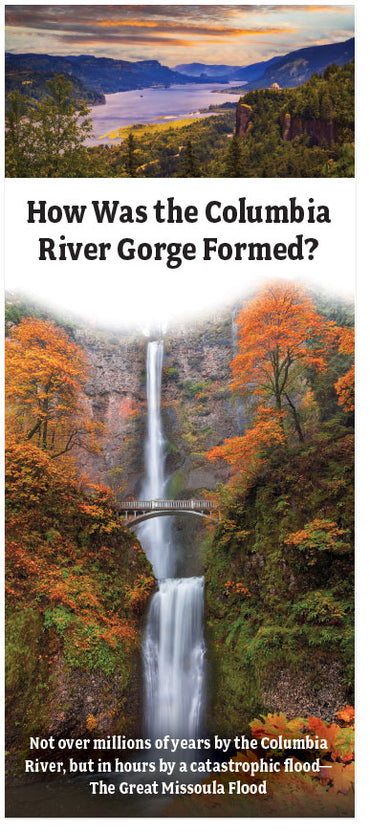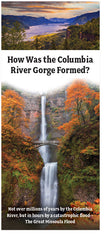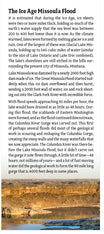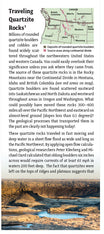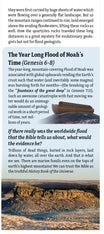How Was the Columbia River Gorge Formed?
Special-Order Folded Flyer Tract
 NOTE: This item is custom-printed to order (click for more details).
NOTE: This item is custom-printed to order (click for more details).
This tract is from our print-on-demand library, and is not kept in stock. Select the options below, and we will custom-print a batch just for you. Because this item is custom-printed, you can add your custom imprint to the back page at no extra cost.
- Estimated shipping date: Friday, January 9 (Click for more details)
- SKU:
- Discounts: Discount coupons do not apply to this item
- Format: Folded Flyer Tract
- Size: 3.66 inches x 8.5 inches
- Pages: 6
- Imprinting: Available with 3 lines of custom text
- Version: NKJV
- Returns: Because this item is custom-printed to order, it cannot be returned.
Show all item details
The full text of this flyer tract is shown below in the NKJV version. (Do you want to print this tract in a different version than the one listed? Contact us and let us know what you're looking for—we may be able to create the alternate version for you at no charge.)
Not over millions of years by the Columbia River, but in hours by a catastrophic flood—The Great Missoula Flood
The Ice Age Missoula Flood
It is estimated that during the Ice Age, ice sheets were two or more miles thick, holding so much of the earth’s water supply that the sea level was between 200 to 400 feet lower than it is now. As the climate warmed, lakes were formed by melting glacier ice and rain. One of the largest of these was Glacial Lake Missoula, holding up to 540 cubic miles of water (similar to the size of Lake Ontario and Lake Erie combined). The lake’s shorelines are still etched in the hills surrounding the present city of Missoula, Montana.
Lake Missoula was dammed by a nearly 2000 foot high dam made of ice. The Great Missoula Flood started suddenly when this ice dam overflowed and then burst, sending a 2000 foot wall of water, ice and rock shooting out into the Clark Fork River with incredible force.
With flood speeds approaching 65 miles per hour, the lake would have drained in as little as 48 hours. During this flood, the scablands of Eastern Washington were formed, and as the flood continued downstream, the Columbia River Gorge was carved out. This first of perhaps several floods did most of the geological work in scouring and reshaping the Columbia Gorge, creating the steep walls and the many waterfalls that we now appreciate. The Columbia River was there before the Lake Missoula Flood, but it didn’t carve out the gorge it now flows through. A little bit of time—48 hours, not millions of years— and a lot of fast moving water did the geological work to form the 90 mile long gorge that is 4000 feet deep in some places.
Traveling Quartzite Rocks1
Billions of rounded quartzite boulders and cobbles are found widely scattered throughout the northwestern United States and western Canada. You could easily overlook their significance unless you ask where they came from. The source of these quartzite rocks is in the Rocky Mountains near the Continental Divide in Montana, Idaho and British Columbia (see red areas on map). Quartzite boulders are found scattered eastward into Saskatchewan and North Dakota and westward throughout areas in Oregon and Washington. What could possibly have moved these rocks 300–600 miles all over the Pacific Northwest and eastward on almost-level ground (slopes less than 0.1 degrees)? The geological processes that transported them in the past are clearly not happening today!
These quartzite rocks traveled in fast moving and deep water in a sheet flow flood as wide and long as the Pacific Northwest. By applying open flow calculations, geological researchers Peter Klevberg and Michael Oard calculated that oblong boulders six inches across would require currents of at least 65 mph in waters 200 feet deep. The fact that quartzites were left on the tops of ridges and plateaus suggests that they were first carried by huge sheets of water which were flowing over a generally flat landscape. But as the mountain ranges continued to rise, land emerged above the eroding floodwaters, lifting these rocks as well. How the quartzites rocks traveled these long distances is a great mystery for evolutionary geologists but not for flood geologists.
The Year Long Flood of Noah’s Time (Genesis 6-8)
The year-long, mountain-covering Flood of Noah was associated with global upheavals rending the Earth’s crust such that water (and inevitably some magma) was bursting forth for months—(the breaking up of the “fountains of the great deep” in Genesis 7:11). Such an awesome catastrophe with fast moving water would do an unimaginable amount of geological work in a short period of time, not millions of years.
If there really was the worldwide flood that the Bible tells us about, what would the evidence be?
Trillions of dead things, buried in rock layers, laid down by water, all over the earth. And that is what we see. There are marine fossils even on the tops of earth’s highest mountains! We can trust the Bible as the truthful History Book of the Universe.
What Is Your Final Destination?
We visit the Columbia River Gorge to enjoy the beauty, wonder, serenity and grandeur of God’s creation. God created the world—and the universe—for us to enjoy. God, our Creator, also wants us to enjoy Him—His goodness, majesty, splendor and holiness. God wants us to glorify Him, and enjoy Him forever. We are not complete until we are in right relationship with our Creator.
Are You Good Enough to Go to Heaven?
It may surprise you, but there will be many “good” people in hell, and many “bad” people in heaven. It’s not about being “good” or “bad.” Have you ever lied, stolen, cheated on a test, or treated someone badly? We all have broken God’s perfect laws. Because we are guilty before a just God, our offenses must be punished. The Bible says, “There is no one who does what is good, not even one” (Romans 3:12, CSB). God’s standard of goodness is perfection—in thought, word and deed. That means that none of us can make it on our own. Even one sin will keep us from heaven.
We Cannot Be Saved by Our Good Deeds
The Bible says, “Not by works of righteousness which we have done, but according to His mercy He saved us” (Titus 3:5). In His mercy, God made a way to forgive us. Our sins cannot be forgiven because our good deeds are more than our bad deeds. We cannot be saved by joining a church or by religious rituals. We are saved only by repenting of our sins and believing in Jesus.
Since everyone has broken God’s laws and deserves punishment, how can anyone ever get to heaven?
The Bible says, “For God so loved the world that he gave his one and only Son, that whoever believes in him shall not perish but have eternal life” (John 3:16, NIV).
Because of God’s great love for us, He provided a way to forgive our sins. Jesus Christ, God’s one and only Son, lived a perfect life, and died on a cross to pay the penalty for our sins. Then He came back to life from the dead. Everyone must trust in Jesus ALONE for salvation. Jesus is the only way to heaven.
“The blood of Jesus his Son cleanses us from all sin” (1 John 1:7, CSB).
Skeptics Corner
“But I don’t believe in God. I am an atheist.”
Here’s what the Bible says—“For ever since the world was created, people have seen the earth and sky. Through everything God made, they can clearly see his invisible qualities—his eternal power and divine nature. So they have no excuse for not knowing God” (Romans 1:20, NLT).
Not believing is a choice that will determine your final destination—rather than Heaven in God’s presence, you will spend eternity in hell without God.
Bibliography and acknowledgements:
GigaFlood, Rick Thompson-the Missoula Flood
1Quartzite article and picture here is in part an excerpt from: “Noah’s long-distance travelers—Quartzite boulders speak powerfully of the global Flood,” Creation Magazine 28, June 2006

